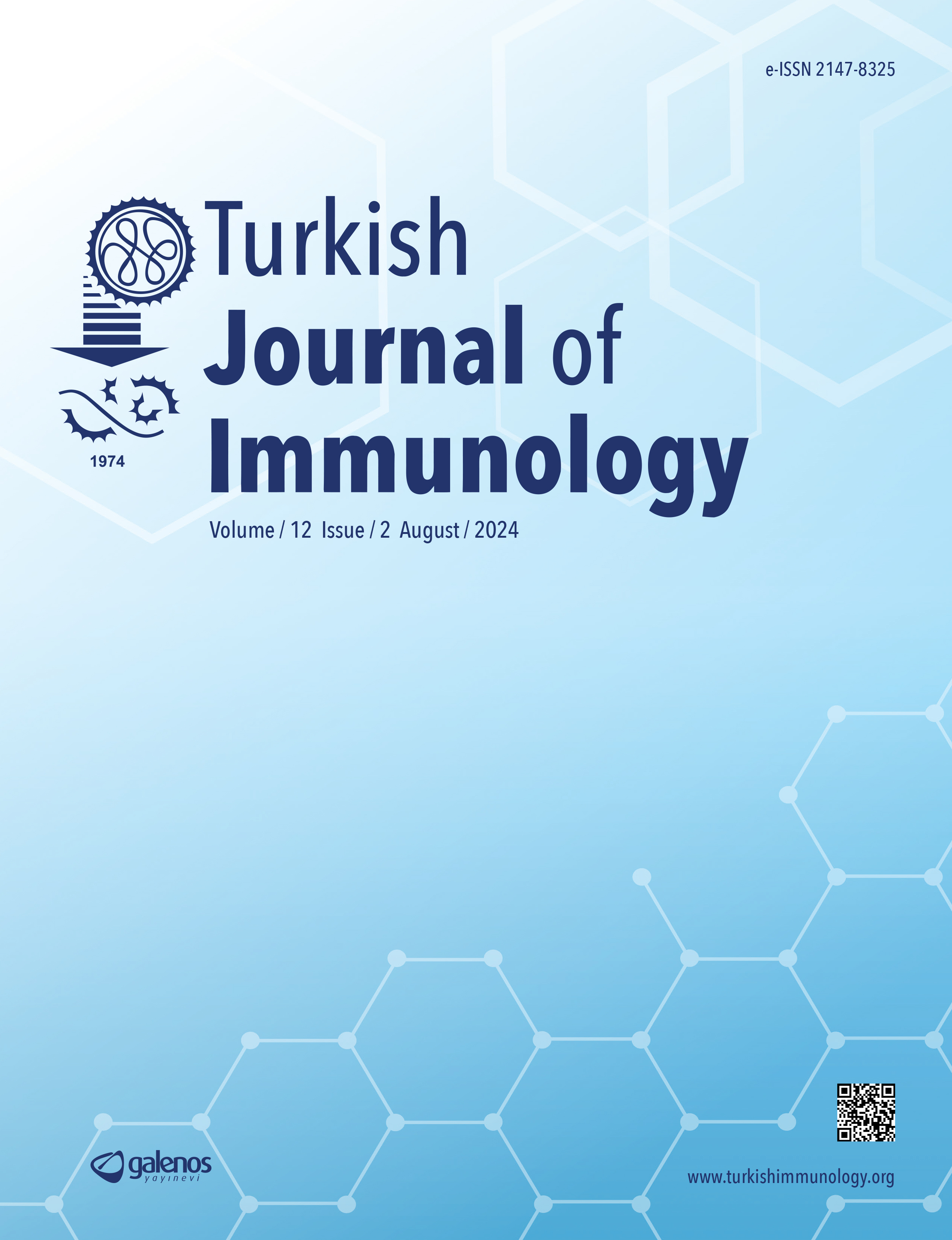Index








Applications



Membership



Volume: 12 Issue: 1 - 2024
| 1. | Cover Page I |
| 2. | Editorial Günnur Deniz Page II |
| ORIGINAL RESEARCH | |
| 3. | Immunomodulatory Potential of Piperine in Rats Alireza Ghavami, Seyyed Meysam Abtahi Froushani, Aliasghar tehrani doi: 10.4274/tji.galenos.2024.20082 Pages 1 - 8 Objective: The ultimate goal of this research was to investigate the immunomodulatory potential of piperine, a black pepper alkaloid, on innate and acquired immune responses in Lewis rats. Materials and Methods: In the first set of experiments, the effects of a one-month oral administration of piperine on the functions of neutrophils and peritoneal macrophages of Lewis rats were investigated. In a separate set of experiments, the effects of piperine gavage on T helper lymphocyte responses in vivo and ex vivo and their subsets were performed in animals challenged with ovalbumin (OVA). Results: Oral administration of piperine for one month reduced the adhesion of neutrophils (p=0.04). The levels of nitric oxide (p=0.0001) and oxygen free radicals (p=0.003) were significantly decreased in peritoneal macrophages of rats treated orally with piperine for one month. Peritoneal macrophages obtained from rats treated with piperine at doses of 40 and 80 mg/kg for one month significantly produced lower levels of interleukin (IL)-12 after lipopolysaccharide stimulation (p=0.006). IL-10 level was significantly elevated in lipopolysaccharide-primed macrophages isolated from rats receiving piperine for one month (p=0.03). Piperine significantly reduced the intensity of delayed-type hypersensitivity responses in rats immunized with OVA (p=0.003). Ex vivo analysis indicated that oral treatment of piperine increased the expression of GATA3 in OVA-immunized rats (p=0.002). Piperine effectively reduced the expression of T-bet and RORγt mRNA in OVA-immunized rats (p=0.001). Piperine did not alter FOXP3 expression in OVA-immunized rats (p=0.15). Conclusion: These findings show that piperine is a modulating agent of innate and acquired immune responses. |
| 4. | Breast Cancer Conditioned Media Modulate the Expression of Immune Checkpoints and Adhesion Molecules in Endothelial Cells İpek Türkdönmez, Emel Şahin, Mehmet Şahin doi: 10.4274/tji.galenos.2024.07078 Pages 9 - 18 Objective: Breast cancer is commonly originated from the cells in the milk ducts or in the lobules that supply milk to the ducts. During cancer development, many actors, including cellular factors such as endothelial and immune cells, and structural factors such as integrins and extracellular matrix elements have gained importance in the tumor microenvironment. Endothelial cells (ECs) not only implicate in cancer growth and metastasis processes, but also are effective in immune cells modulations. In the present study, we investigated the effect of secretome released by breast carcinoma cell lines on endothelial expression of immune checkpoints and adhesion molecules. Materials and Methods: In this study, the expression levels of some immune checkpoints, including lymphocyte-activation-protein 3 (LAG-3), V-domain Ig suppressor of T-cell activation (VISTA), Indoleamine-2,3-dioxygenase (IDO), IDO-2, programmed cell death 1 ligand (PD-L1), PD-L2, Cytotoxic T-lymphocyte associated protein 4, (CTLA-4), and some adhesion molecules, including E-cadherin, VE-cadherin, E-selectin, platelet EC adhesion molecule-1 (PECAM-1), vascular cell adhesion molecule-1 (VCAM-1), intercellular adhesion molecule-1 (ICAM-1), were measured using quantitative real-time polymerase chain reaction in HUVEC ECs preincubated with the conditioned media (CM) collected from normal (CRL-4010) and carcinoma cells (CRL-2329 and MDA-MB-231). Besides, endothelial proliferation and migration were also examined. Results: CRL-2329-CM was found to increase cell proliferation at the end of 48 h but not 24 h, compared to the control (CRL-4010-CM) group (p=0.0052). In addition, both cancer cell-CMs were revealed to induce migration (p<0.001). VE-cadherin, ICAM-1, PECAM-1, VCAM-1, and E-selectin gene expressions were found to be increased significantly in the 48 h groups (p<0.001). The expression levels of PD-L1 (p=0.0028 and p<0.001), PD-L2 (p=0.0216 and p<0.001), IDO-1 (p<0.001), LAG3 (p<0.001 only for MDA-MB CM group), VISTA (p<0.001) genes in 48 h groups, and PD-L2 (p=0.0084 and p=0.0045) gene in 24 h groups, were significantly increased. However, we found that there were no expressions of IDO-2, CTLA-4 and E-cadherin genes in ECs. Conclusion: This study has shown that secretome produced by breast carcinoma cell lines may promote endothelial proliferation and migration and support metastasis. Also, secretome can be effective on immune modulation. |
| 5. | Effects of Adipose-tissue Derived Mesenchymal Stem Cells on PBMCs in Co-culture with HeLa Cell Line Maryam Dorfaki, mahdi ghatrehsamani, fahimeh Lavi Arab, Mona Roozbehani, Majid Khoshmirsafa, Reza Falak, Fatemeh Keshavarz, Fatemeh Faraji doi: 10.4274/tji.galenos.2024.35219 Pages 19 - 27 Objective: Cervical cancer, the most common reproductive system cancer being women, is the fourth leading cause of cancer-related deaths. The use of mesenchymal stem cells (MSCs) for treating various diseases is being studied, but their use in cervical cancer has not been well explored. In this study we study investigated the effect of adipose tissue-derived MSCs on the apoptosis and proliferation of peripheral blood mononuclear cells (PBMCs) in co-culture with the HeLa cell line. MSCs were isolated from adipose tissue and then co-cultured with PBMCs, and HeLa cells at different time points (24, 48, and 72 hours). Materials and Methods: The effect of MSC cells on proliferation, apoptosis, and gene expression of the cytokines tumor necrosis factor alpha (TNF-α), transforming growth factor beta (TGF-β), interleukin (IL)-4, IL-2, and interferon-γ in PBMCs cultured together with HeLa cells was investigated using flow cytometry and real-time polymerase chain reaction (PCR), respectively. Results: Flow cytometry showed that co-culture of PBMCs/MSCs/HeLa significantly increased the proliferation of PBMCs at different time points, with a p-value of 0.0022. In addition, MSCs significantly decreased apoptosis of PBMCs in co-culture with HeLa at 48 h. the p-value was 0.0022. Real-time PCR showed that the expression of TGF-β in PBMCs/MSCs/HeLa co-culture increased after 24 h, with a p-value of 0.006. Conclusion: These data showed that adipose-derived MSCs can stimulate the proliferation and survival of PBMCs and enhance the apoptosis of HeLa cells, indicating their potential as immunomodulatory therapy for cervical cancer cells. However, further research is required to fully understand the underlying mechanisms and optimize therapeutic approaches involving PBMCs and MSCs. |
| 6. | Peripheral Expression of IL-6, TNF-α and TGF-β1 in Alzheimers Disease Patients Gamze Güven, Pınar Köseoğlu, Ebba Lohmann, Bedia Samancı, Erdi Şahin, Başar Bilgiç, Haşmet Ayhan Hanağası, Hakan Gürvit, Nihan Erginel-Ünaltuna doi: 10.4274/tji.galenos.2024.76598 Pages 28 - 34 Objective: Neuroinflammation is involved in the pathology of Alzheimers disease (AD). Peripheral levels of various inflammatory cytokines are altered during AD pathogenesis. This study aimed to examine the role of peripheral inflammation in AD pathogenesis by measuring serum levels and gene expression of specific inflammatory cytokines in AD patients. Therefore, we analyzed serum interleukin-6 (IL-6) and transforming growth factor-beta 1 (TGF-β1) levels and mRNA expressions of IL-6 and tumor necrosis factor-alpha (TNF-α) in peripheral blood mononuclear cells of AD patients and controls. Materials and Methods: We quantitatively assessed serum IL-6 and TGF-β1 levels in 25 AD patients and 33 age-matched controls using enzymelinked immunosorbent assay. In addition, we evaluated the mRNA expressions of IL-6 and TNF-α in peripheral blood mononuclear cells from 31 AD patients and their respective controls (n=30) via quantitative real-time polymerase chain reaction. Results: AD patients tended to have higher serum IL-6 and TGF-β1 levels compared to the controls, but the difference was not statistically significant. IL-6 and TNF-α mRNA expression was significantly downregulated in AD patients compared to the controls (p=0.000 and p=0.004; respectively). Serum IL-6 and TGF-β1 levels were negatively correlated with age in AD patients (p=0.025, r=-0.467 and p=0.035, r=-0.431; respectively). Conclusion: The outcomes of this study suggest a disruption in the peripheral immune response in individuals with AD. The observed decreased expression of cytokine genes in peripheral leukocytes may indicate a contributory mechanism through which peripheral cytokines influence AD pathogenesis. |




